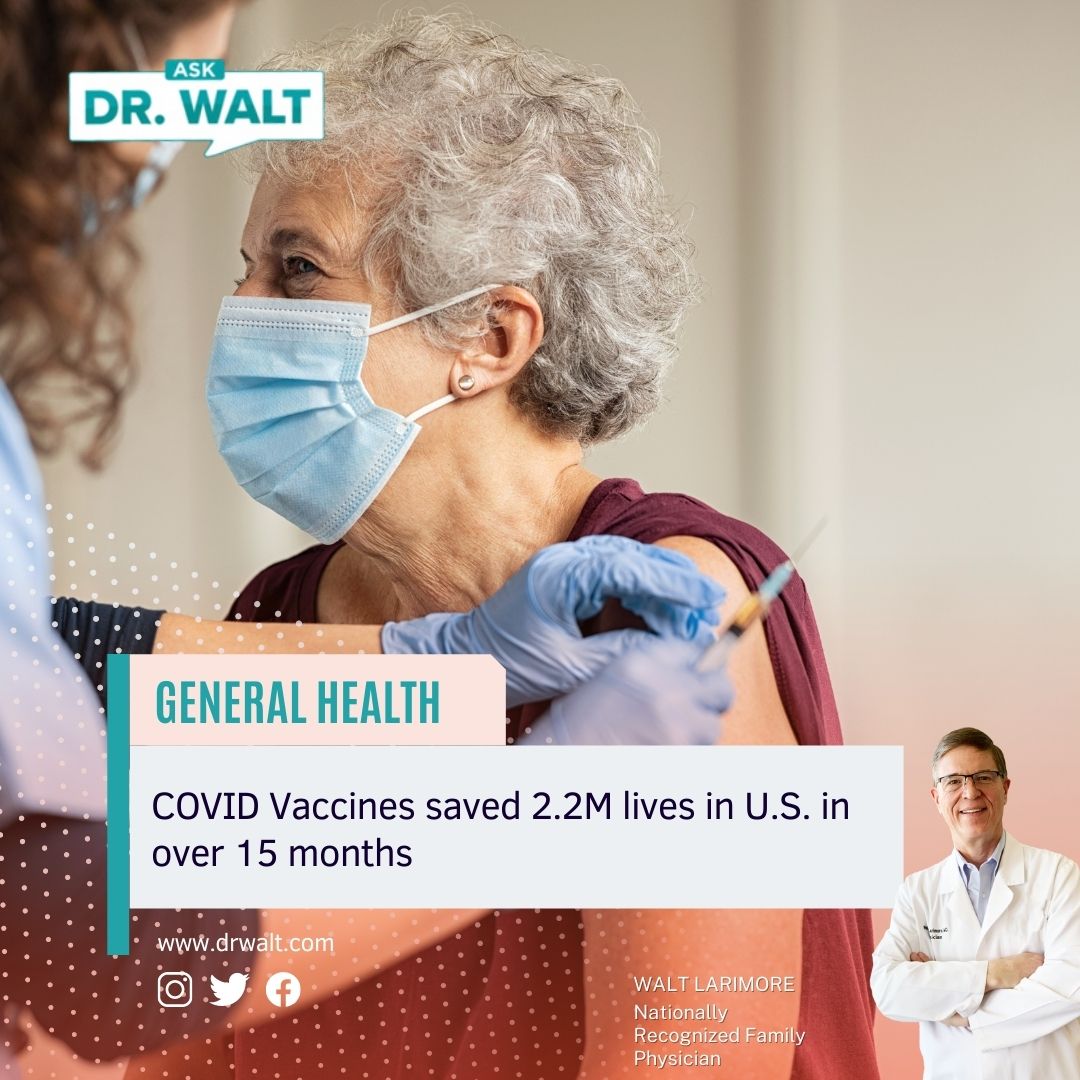
COVID Vaccines saved 2.2M lives in U.S. in over 15 months
May 4, 2022
Vaping may lead to inflammatory changes in organs
May 6, 2022ConsumerLab.com is reporting on an observational study among nearly 10,000 adults (average age 46) in the U.S. who were followed for about 10 years that found that those with high blood levels of vitamin C (about 60 mcmol/L or 1.06 mg/dL or greater) had a 33% greater risk of all-cause mortality and 60% greater risk of cardiovascular disease mortality compared to those with lower levels.
This blood level of vitamin C is at the higher end of what is considered adequate (48 to 70 mcmol/L) and is close to saturated levels. Also, ConsumerLab points out other concerns have been raised:
- Too much vitamin C may increase the risk of cataracts. Over the long-term (10 years or more), it seems that low-dose vitamin C (60 mg to 250 mg) may help prevent cataracts, while high doses (above 500 mg) may have a negative effect.
- Vitamin C supplementation may increase the risk of kidney stones (above 1000 mg a day).
- Vitamin C may also interfere with the absorption of tricyclic antidepressants and anticoagulants.
- Excess vitamin C from supplements can interfere with diagnostic tests for cholesterol and sugar levels in the blood, as well as for blood in the stool.
- The risk of liver damage from high doses of acetaminophen (Tylenol®) may be increased if you also take large doses (more than 3000 mg a day) of vitamin C.
- Because vitamin C improves iron absorption, people with diseases that cause them to store too much iron should use vitamin C only with caution.
ConsumerLab writes, “Vitamin C is safe when taken in moderate amounts but be aware that too much vitamin C can cause diarrhea and other gastric disturbances, such as heartburn.”
They add, “Keep in mind that unless you are taking a buffered form of vitamin C (such as calcium ascorbate or sodium ascorbate), vitamin C is acidic. To reduce gastric side effects, divide the dose over the course of a day and take it with meals.”
The Tolerable Upper Intake Level (UL) (i.e., the maximum daily amount likely to be safe for the vast majority of healthy people) for vitamin C in adults is 2,000 milligrams — based on total intake from foods, beverages, and supplements.
The upper level for tolerable intake is 400 mg/day for children ages 1 to 3, 650 mg/day for children ages 4 to 8, 1,200 mg/day for children ages 9 to 13, and 1,800 mg/day for teens ages 14 to 18 ages.
Individuals are generally advised not to exceed these levels unless under medical supervision.
To answer the question, “How much vitamin C should I take?” ConsumerLab advises:
To be sure you’re getting the daily requirement of vitamin C, a supplement providing roughly 50 mg to 100 mg of vitamin C is sufficient for most adults and is quite safe. Be aware, however, that taking more than 500 mg of vitamin C per day on a regular basis (which will saturate your blood with vitamin C) may increase your risk of developing cataracts, and taking more than 1,000 mg per day may also increase your risk of kidney stones. In fact, while adequate levels of vitamin C in the body are associated with reduced risk of death, this appears to reverse at higher levels. Diarrhea can result from a single dose of more than 2,000 mg for an adult and lower amounts for children (see Concerns and Cautions). In short, there is a risk/benefit trade-off when taking high-dose vitamin C.
© Copyright WLL, INC. 2022. This blog provides healthcare tips and advice that you can trust about a wide variety of general health information only and is not intended to be a substitute for professional medical advice, diagnosis, or treatment from your regular physician. If you are concerned about your health, take what you learn from this blog and meet with your personal doctor to discuss your concerns.





3 Comments
Walt, just want you to check out whether or not your statement that vitamin C can help Iron absorption is correct. It is a assumed well-known fact but it didn’t have a good data behind it. PCMA reviewed an article several months ago that refuted that pretty well. I listen to PC MA on Em-Rap. But of course I am pretty skeptical of vitamin C and tell my patients that it’s only good when you’re sick it doesn’t prevent anything. In spite of what Linus Pauling touted According to Art Robinson of Oregon Institute Of Science And Medicine, Pauling’s close associate.
Continue to enjoy your emphasis. Now that I’m retiring maybe I’ll have to start up something like that. Any pointers??
Dr. Miller,
Thanks for the note. In the ConsumerLab review, which is hyperlinked to the blog, they add, “Although some experts recommend taking vitamin C to boost iron absorption, research suggests it is unlikely to have a significant effect.”
In their “Iron Supplements Review,” they add:
A reader named Danae wrote, “If 1000 mg can contribute to cataracts, then why the standard recommendation to take 2000 mg?” However, Danae posted this question on another blog (vegetarian diets for kids). So, here’s the answer I wrote:
Hello Danae,
Thanks for writing. I suspect you’re writing about the vitamin C blog of 05/08/2022 on “Too much vitamin C potentially dangerous,” (and not the blog on vegetarian diets for kids). If that’s correct, then you’ve asked a great question. I can see how my vitamin C blog might be confusing. Let me try to explain:
The FDA’s determination of the “Tolerable Upper Intake Level” of any substance is based upon their determination of “the maximum daily amount likely to be safe for the vast majority of healthy people.” But, of course, that does NOT mean higher doses are safe for all people.
Obviously, every substance (food, medications, over-the-counter meds), including natural medicines (herbs, vitamins, and supplements) has potential benefits and also potential risks. And, in general, the higher the dose, the more potential risks.
For example, with vitamin C, the most commonly reported adverse effects are abdominal cramps, esophagitis, heartburn, headache, osmotic diarrhea, nausea, and vomiting — and adverse effects are more likely to occur at doses above the tolerable upper intake level of 2000 mg a day. However, some adverse effects, like kidney stones and cataracts can occur at doses below 2000 mg a day.
Kidney stones have been reported in those prone to kidney stones at doses of 1000 mg a day. As far as cataracts, I think I’ll edit the information to say, “Too much vitamin C may increase the risk of cataracts. Over the long-term (10 years or more), it seems that low-dose vitamin C (60 mg to 250 mg) may help prevent cataracts, while high doses (above 500 mg) may have a negative effect.”
Also, I’ll add this from Consumer Lab also:
How much vitamin C should I take? To be sure you’re getting the daily requirement of vitamin C, a supplement providing roughly 50 mg to 100 mg of vitamin C is sufficient for most adults and is quite safe. Be aware, however, that taking more than 500 mg of vitamin C per day on a regular basis (which will saturate your blood with vitamin C) may increase your risk of developing cataracts, and taking more than 1,000 mg per day may also increase your risk of kidney stones. In fact, while adequate levels of vitamin C in the body are associated with reduced risk of death, this appears to reverse at higher levels. Diarrhea can result from a single dose of more than 2,000 mg for an adult and lower amounts for children. In short, there is a risk/benefit trade-off when taking high-dose vitamin C.
Does this help?
Again, thanks for writing.
Dr. Walt
You’ll now see these edits in the text above.